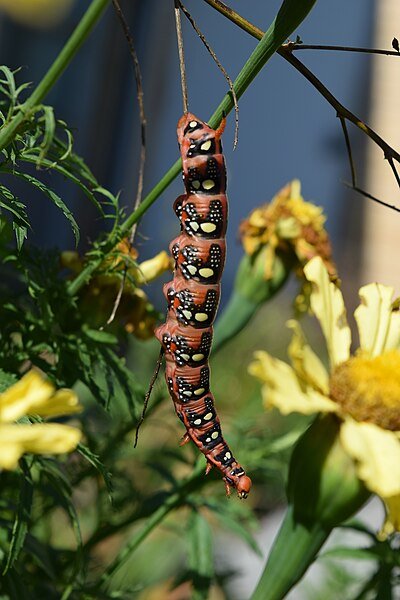Marigolds are a gardener’s delight, known for their vibrant colors, hardy nature, and ability to repel certain pests. But every gardener who has lovingly tended to these golden blooms knows the heartbreak of finding their marigold plants mysteriously nibbled or damaged.
If you’ve ever stared at a chewed-up marigold and wondered, “Who’s the culprit?” you’re not alone. Let’s dive deep into the list of insects and animals that feast on marigolds, exploring their habits, preferences, and how you can protect your beloved flowers.
1. Slugs and Snails: The Midnight Marauders
If your marigold leaves look like Swiss cheese or you find slimy trails on your plants, you’re dealing with slugs or snails. These nocturnal feeders thrive in damp conditions and have a penchant for young marigold leaves and flowers. They may seem slow and harmless, but their appetite is anything but unbelievable.
How to Spot Them: Look for their tell-tale silvery slime trails and jagged edges on leaves. They often hide under pots or mulch during the day.
Control Tips: Use crushed eggshells, copper tape, or diatomaceous earth around your plants to create a barrier. Beer traps are also a tried-and-true method to lure and eliminate them. Regularly check under pots and garden decorations to remove hiding spots.
Why They Love Marigolds: Slugs and snails are drawn to the tender, juicy leaves of marigolds. Younger plants are particularly vulnerable, as their leaves are softer and easier to chew. Their nocturnal nature makes them stealthy, leaving gardeners to wake up to their handiwork without witnessing the actual damage. These creatures thrive in gardens with dense foliage and moist soil, making proper spacing and watering techniques critical in keeping them at bay.
2. Aphids: The Silent Sap-Suckers
Aphids are tiny, soft-bodied insects that cluster on marigold stems, leaves, and buds. They feed on the sap, leaving behind a sticky residue called honeydew, which can attract ants or lead to sooty mold.
How to Spot Them: Look for tiny green, black, or yellow insects on the undersides of leaves and stems. Wilting leaves and stunted growth are also signs of an aphid infestation. You might also notice ants protecting aphids to harvest their honeydew.
Control Tips: Introduce ladybugs or lacewings, natural predators of aphids, or spray your plants with a mixture of water and mild soap. Regular pruning of infested areas can also help prevent the spread. Keeping weeds under control and ensuring proper air circulation can deter aphids from settling on your plants.
Why They Love Marigolds: Aphids are attracted to the vibrant blooms and succulent stems of marigolds, which provide a rich source of sap for their nourishment. Their rapid reproduction means that even a small infestation can quickly get out of hand, making vigilance crucial for gardeners. They prefer tender, new growth, so keep an eye out during peak growing seasons.
3. Grasshoppers: The Hungry Hoppers
Grasshoppers are notorious for chomping through marigold foliage. Their powerful jaws can devour entire leaves in no time, leaving your plants ragged and forlorn.
How to Spot Them: Grasshoppers are easy to see but quick to escape. Look for large, irregular holes in the leaves and sometimes even partially eaten flowers.
Control Tips: Use row covers to protect your plants or apply organic insecticides like neem oil. Chickens or ducks, if you keep them, can also help keep the grasshopper population in check. Creating habitats for natural predators like birds can also help. Encouraging biodiversity in your garden reduces the likelihood of a grasshopper outbreak.
Why They Love Marigolds: Grasshoppers are generalist feeders and will munch on almost anything green, but marigold leaves’ soft texture makes them an easy target. They are especially problematic in warm, dry climates where their populations can explode. Their insatiable appetite can strip plants bare, so timely intervention is essential.
4. Japanese Beetles: The Iridescent Invaders
Japanese beetles are both beautiful and destructive. They feed on marigold petals, leaves, and stems, often leaving behind skeletonized foliage.
How to Spot Them: These metallic-green beetles are often found munching in groups during the day. You might notice clusters of leaves with only their veins remaining.
Control Tips: Hand-pick them early in the morning when they’re less active. Drop them into soapy water to prevent their return. Traps can be effective but place them away from your garden to avoid attracting more beetles. Consider planting trap crops to lure them away from your marigolds.
Why They Love Marigolds: Japanese beetles are drawn to the bright colors and tender petals of marigolds, which make for a delectable feast. Their tendency to feed in groups can lead to severe damage in a short period, making them a formidable foe. Their presence often indicates the need for a broader pest management strategy in your garden.
5. Caterpillars: The Voracious Vegetarians

Caterpillars, including those of moths and butterflies, can wreak havoc on marigold plants. While some species, like the monarch caterpillar, are beneficial, others can decimate your plants overnight.
How to Spot Them: Look for chewed leaves and frass (caterpillar droppings) on or near the plant. You might also spot the culprits themselves, blending into the foliage.
Control Tips: Hand-pick caterpillars or use Bacillus thuringiensis (Bt), a safe biological control method. Encourage birds in your garden, as they are natural predators of caterpillars. Planting companion plants like dill or parsley can attract caterpillars away from your marigolds.
Why They Love Marigolds: Caterpillars are after the nutrient-rich leaves of marigolds, which provide the energy they need to grow and transform. While their presence can be frustrating, remember that they’re part of the natural cycle of your garden. Learning to differentiate between harmful and beneficial species is key to managing them effectively.
6. Rabbits: The Furry Garden Foes
Don’t be fooled by their cute, fluffy appearance—rabbits can mow down marigolds in a single sitting. They are highly adaptable and can squeeze through tight spaces to reach their favorite snacks. Rabbits prefer young, tender marigold plants and are most active at dawn and dusk, making their feeding habits challenging to spot in real-time.
How to Spot Them: Look for cleanly nibbled stems, scattered droppings resembling small pellets, and small paw prints in the soil. If your garden borders a wooded area or open field, you’re more likely to encounter rabbit activity.
Control Tips: Install a wire mesh fence around your garden that is buried at least 6 inches deep to prevent them from burrowing underneath. Use rabbit repellents made from predator urine or strong-smelling substances like garlic or chili. Planting marigolds alongside less palatable plants, such as onions or lavender, can also deter them. Combining physical barriers with deterrents offers comprehensive protection.
Why They Love Marigolds: Rabbits are attracted to the sweet scent and tender texture of marigolds, which make them a frequent snack. Their relentless appetite means they can cause significant damage if left unchecked. Observing their behavior can help identify their entry points into your garden, allowing you to fortify those areas effectively. If you’re facing persistent issues, consider consulting with local wildlife experts for tailored solutions.
7. Deer: The Elegant Browsers
Deer are less likely to eat marigolds because of their strong scent, but in times of food scarcity, these majestic creatures won’t hesitate to sample your flowers. Their browsing habits can damage marigolds and surrounding plants, especially during harsh winters or droughts when other food sources are limited.
How to Spot Them: Look for torn leaves and trampled plants, as deer are less precise eaters compared to smaller animals. You might also see hoof prints in the soil or droppings resembling small, dark pellets.
Control Tips: Use deer-resistant plants as a barrier around your marigolds or apply strong-scented sprays containing ingredients like garlic or rotten eggs to deter them. Motion-activated sprinklers can startle deer and discourage their visits. Adding thorny or aromatic plants such as rosemary or holly nearby can further dissuade them. For larger areas, installing a high fence is a more permanent solution.
Why They Love Marigolds: While not their first choice, marigolds can become a meal when other food sources are scarce. Deer are opportunistic feeders, and their presence can serve as both a blessing and a challenge for gardeners. Building a multi-layered defense and staying vigilant during critical feeding seasons is crucial if deers frequently visit your area.
8. Thrips: The Tiny Troublemakers
Thrips are minuscule insects that feed on marigold petals and leaves, causing discoloration and distortion.
How to Spot Them: Look for silvery streaks on leaves and speckled petals. Affected plants may also show stunted growth.
Control Tips: Introduce beneficial insects like predatory mites or use insecticidal soap sprays. Regular pruning and removing affected leaves can help manage infestations. Keeping your garden clean and free of debris minimizes hiding spots.
Why They Love Marigolds: Thrips are attracted to the bright colors and nutrient-rich petals of marigolds, which serve as both food and shelter. Their small size makes them difficult to detect, often leading to extensive damage before they’re noticed. Early intervention is vital to controlling their spread.
9. Earwigs: The Nighttime Nibblers
These creepy-crawly insects feed on marigold petals and leaves under the cover of darkness.
How to Spot Them: Earwigs typically leave behind ragged, unevenly chewed petals and small, irregular holes in the leaves. During the day, they hide in dark, moist areas such as under mulch, rocks, or garden debris. Spotting them may require checking these hiding places, especially if damage appears overnight.
Control Tips: To manage earwigs, create traps using rolled-up damp newspapers or cardboard tubes. Leave these traps near your plants overnight, then dispose of them in the morning. Applying diatomaceous earth around your marigolds can act as a natural deterrent, as its abrasive texture discourages earwigs from crossing it. Keeping your garden clean and free from excessive mulch or plant debris can reduce their hiding spots.
Why They Love Marigolds: Earwigs are drawn to the soft, tender petals and foliage of marigolds, which provide a convenient and satisfying meal. These insects are particularly active during warm, humid weather, thriving in environments where they can easily access both food and shelter. Their nocturnal behavior often results in significant damage before gardeners even realize they’re present.
10. Birds: The Feathered Foragers
While not the most common culprits, birds occasionally target marigolds, especially during nesting season when they’re searching for soft materials to line their nests. Some species may also peck at the flowers for food or simply out of curiosity.
How to Spot Them: Signs of bird activity include peck marks on petals and stems, scattered flower debris, or increased avian presence in your garden. You might also notice marigold flowers looking ragged or partially destroyed without any apparent insect activity.
Control Tips: To protect your marigolds from birds, consider using reflective tape, wind chimes, or other visual deterrents that can scare them away. Garden netting placed over your marigolds is another effective option, preventing birds from reaching the flowers. Providing alternative food sources, such as bird feeders filled with seeds or suet, can divert their attention and reduce the likelihood of them targeting your plants.
Why They Love Marigolds: Birds are naturally attracted to the bright colors of marigold flowers, which can pique their curiosity. Additionally, the soft petals are ideal for use as nesting material, making marigolds a convenient resource during the breeding season. While their occasional foraging may not cause severe damage, it’s worth taking preventative measures to ensure your plants remain intact.
Final Thoughts
As you’ve seen, a variety of insects and animals might be responsible for the damage to your marigolds. While it’s frustrating to see your hard work undone, understanding these culprits can empower you to take action. Remember, every garden ecosystem has its challenges, but with patience and persistence, you can protect your plants and enjoy their beauty all season long. Keep observing, experimenting, and learning to become a true guardian of your garden.



